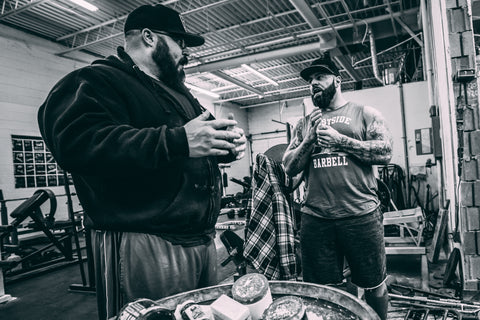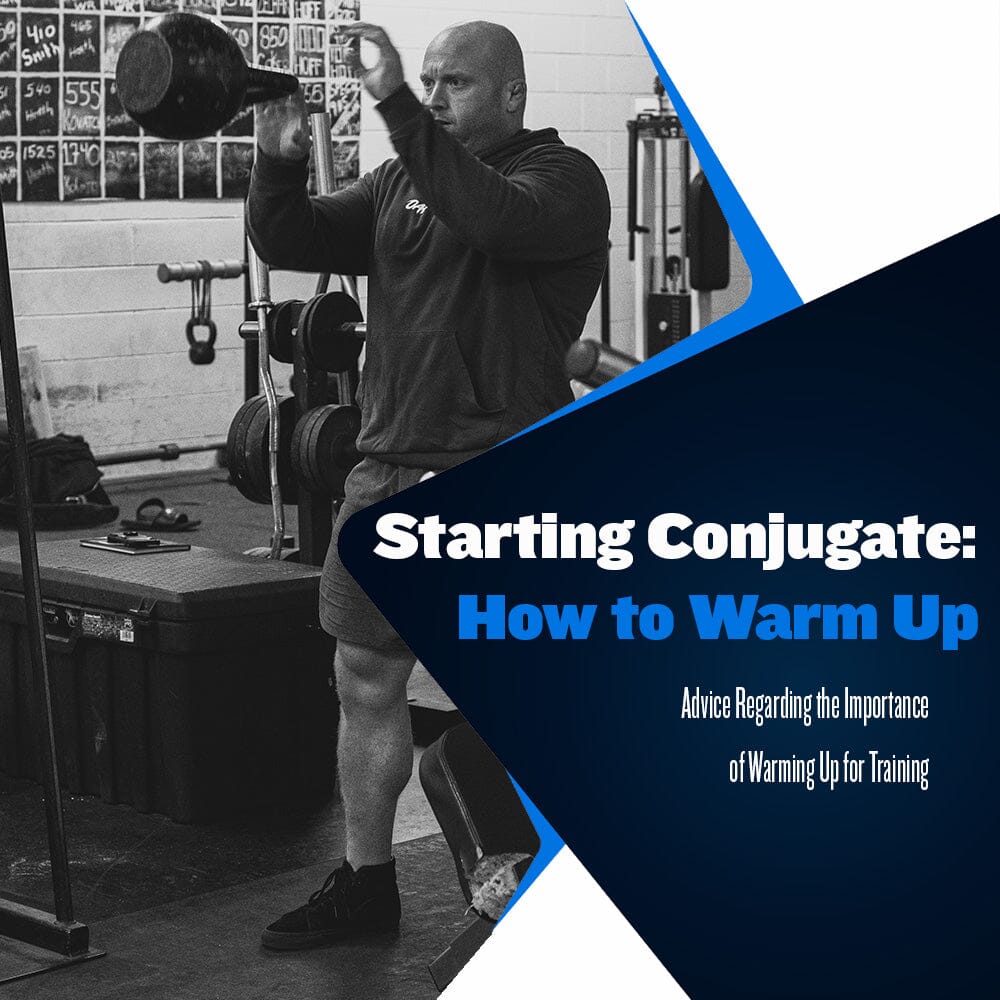Starting Conjugate: How to Warm-Up

As a beginner or someone new to the Conjugate Method, it is important to understand how to set yourself up for successful and productive training days. How an athlete prepares for each training day is vital because it will ultimately affect the rate at which the athlete improves strength, conditioning, and coordination. Without proper preparation, the athlete is in a less-than-optimal state, incapable of training at total capacity.
If the athlete frequently attempts workouts underprepared, gains in strength will stagnate, and the risk of injury will rise significantly. The most significant factors regarding training preparedness are:
- The calories consumed and the level of hydration maintained 24 hours before training.
- The amount of sleep you average per night.
- The way you warm up for your training day.
While the first three factors are factors the athlete must address at home on their own, the warm-up portion falls on the coach to design and implement. If you have followed strength training on social media for the past five years, you likely have noticed that much of the content focuses on adequately warming up for a training day.
Social media has become a useful and powerful tool for strength coaches and educators to reach and teach the masses, and this is for sure. However, at times, certain aspects of the training process become overanalyzed or overemphasized for the sake of content. There is no doubt warm-ups fall into this category.
Focusing on the warm-up portion of a training day is good for business if you are in the strength and conditioning content creation game. When it comes to methods and movements, endless combinations can be created and argued as worthwhile warm-ups. This is great for the content creator but can confuse their followers.
What is a Warm-Up?
A warm-up is an individual exercise or combination of exercises intended to prepare the musculoskeletal system for the intensity, volume, and movements programmed for the training day. The goal of a warm-up is simple, to reach a state of readiness that allows the athlete to execute the movements correctly and relatively pain-free.
Think about it; not a tremendously complex problem to solve. Unless you are training at an older age (age 50+) or are dealing with current or prior injury issues, it shouldn't take much to prepare for the first movement of the training day.
Today, if you walk into a public gym, you will notice many people performing warm-up rituals for 20-30, sometimes even 45 minutes, before they touch a barbell. While this may be called for in some cases, it would be hard to believe all of these folks are over 50 or have significant issues with movement or pain due to prior or current injuries.
Unfortunately, these folks have been convinced that they must perform a certain protocol before training to remain safe and avoid injury. Instead of preparing the body for the training day, many warm-ups prepare the mind so that the athlete feels safe enough to train.
A lack of confidence in physical ability or durability is something often found in athletes new to barbell training. Under normal circumstances, this lack of confidence dissipates as the athlete gains experience. However, with the social media warm-up hyperfocus, many of these athletes are programmed to perform specific warm-ups no matter their level of strength and fitness.
At that point, is it a warm-up, a ritual, or a waste of time and energy? A proper warm-up is whatever movements or exercises best prepare the individual athlete for the training day. Warm-up approaches will vary depending on the athlete, so be wary of anyone purporting to have a one-size-fits-all approach to warm-ups. Your warm-up should prepare you for the first set of the main exercise, nothing more, nothing less.
I want to make an important point: trust in your physical toughness and durability. Walking around believing that training is dangerous and you are prone to injury is a self-fulfilling prophecy. The human body can handle tremendous stress, strain, and damage. Training success involves belief in self, intelligent programming, and graded exposure and acclimation to the training tasks and demands.
Westside Warm-Ups
If you walk into Westside on a routine training day before the main exercise begins, you will see athletes executing warm-ups differently. On a lower day, you may see some athletes swinging kettlebells while others hit some belt squats or a few sets of Reverse Hypers. On an upper day, the warm-up movements are typically tricep and shoulder-focused. We will add posterior shoulder and back work if mobility is restricted due to prior max effort lower training.
I do not like to spend too much time warming up. Usually, I warm up with the barbell performing the movement I have scheduled as the main exercise of the day. If I need a few extra sets at lighter weights to feel warmed up, I'll do that. Otherwise, I start warming up by taking my standard jumps in weight. However, I will perform a simple warm-up if mobility or pain is an issue.
In contrast, my training partner Jake Anderson will typically perform a basic warm-up routine prior to each training day. Still, it is nothing fancy, structured, or in-depth, just enough work to feel ready to train. Given that Jake is capable of training at significantly high levels of volume and intensity without issue, I surmise his warm-up routine is more about his drive to train than his need to feel able to train. Some people like to do extra work.
Based on my experience at Westside Barbell, here are the upper and lower warm-up exercises I have most commonly used or seen used:
Lower Body
Reverse Hypers
Belt Squats
Kettlebell Swings
Goblet Squats
Good Morning Machine
Sled Drags
Wheelbarrow Walks
Standing Abs
Upper Body
Bamboo Bar Bench
Dumbbell Bench
Chest-Supported Rows
Y Raises
Lateral Raises
Front Raises
Tricep Pressdowns (Cable or Band)
Rolling Dumbbell Tricep Extensions
Dumbbell Overhead Press
Face Pulls
Band Pull Aparts
Band Shoulder Dislocates
You will notice that no set or rep guidelines have been provided. The optimal warm-up volume will depend on the individual. We choose a couple of exercises and perform the number of sets and reps needed to feel prepared to train, nothing more. The goal is to roll into the first set of the main exercise with as much energy in reserve as possible.
Basic Warm-Ups for Beginners
While we may not require an extensive warm-up at Westside Barbell, that does not mean beginners should scrap the warm-up portion of their training programs. As you become a more experienced lifter, your body becomes more acclimated and ready for the task it presumes is on the horizon; more lifting of heavy weights. However, as a beginner, you will not have that same level of preparedness.
In this case, it is good to perform a basic warm-up each training day prior to performing the main exercise. Here are a couple of warm-up exercises that will prepare you for a lower or upper-body training day when using the Conjugate Method:
Lower Body
Sled Drags: 8-10 trips at 15-20 yards per trip or one extended trip lasting two minutes or more. Load the sled with body weight.
Reverse Hypers: 3 x 15-20
Belt Squats: 3 x 10-15
Kettlebell Swings: 3-4 x 12-15
Standing Abs: 3 x 15-20
Goblet Squats: 3 x 12-15
Upper Body
Bamboo Bar Bench: 4 x 12-15
Rolling Dumbbell Tricep Extensions: 3 x 15
Y Raises: 3 x 15
Chest-Supported Rows: 3 x 12
Push-Ups: 3 x 15 (incline or flat)
Face Pulls: 3 x 12-15
Band Pull Aparts: 3 x 15
You're likely reading this and thinking, "that's too much volume for a warm-up," and you'd be correct if the intent were to perform all of these exercises using the heaviest weights we can use. However, the approach is exactly the opposite. You want to choose at least one, up to three, warm-up movements to perform each training day. When performing these warm-up exercises, you will use the lightest effective weight possible.
The idea is to warm up for training, not begin the actual training.
Know Yourself
An essential part of the training process for athletes is to develop an understanding of personal abilities and limitations in sports and the gym. Every human being on the planet is different to some degree, so there is genuinely no one-size-fits-all approach to anything when it comes to training or execution of movements.
A big part of finding success as an athlete is finding what works for you. If you are constantly following the one-minute video recommendations of content creators who have no experience working with you on an individual level, how likely is it that these recommendations suit you best? Do not be fooled into blindly trusting the recommendations of someone on a screen; believe in the experiences and feedback you receive from your training and make adjustments accordingly.
Do you need a warm-up? I don't know, do you? If you don't know the answer, follow the beginner warm-up recommendations. Otherwise, use your judgment, avoid unnecessarily wasting energy, and get underneath the barbell the minute you feel ready to.
Before blaming a bad training day, poor performance, or injury on your warm-up protocol, consider that it may be due to inadequate calorie intake, hydration, or sleep. While less ripe for content creation, these factors typically play the most significant role in training quality. Repeated training success depends on your discipline outside of the gym, not the warm-ups you perform at the gym.
Sources:
Simmons, L. (2007). Westside Barbell Book of Methods. Westside Barbell.
Verkhoshansky, Y., & Siff, M. C. (2009). Supertraining. Verkhoshansky.





